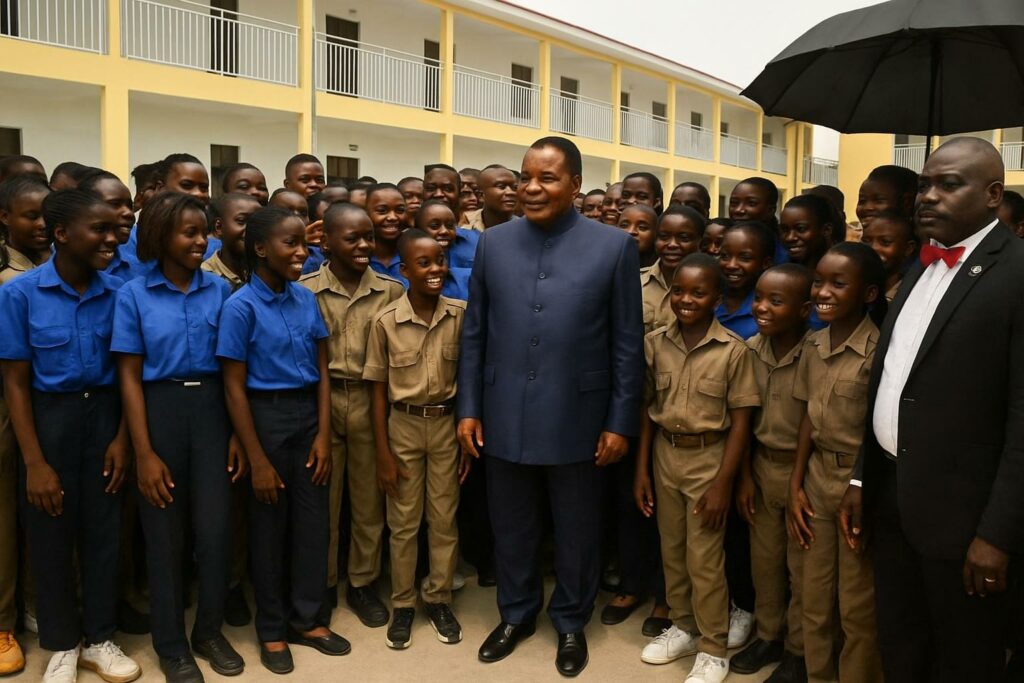A flagship campus reshaping northern Brazzaville
The afternoon sun of 24 October bathed the northern suburb of Talangaï as President Denis Sassou Nguesso cut the tricolour ribbon of the Liberté School Complex, a project long anticipated by parents and teachers alike. Rising on three hectares in the vibrant 6th arrondissement, the campus comprises twenty-four buildings—twelve of them two-storey blocks—surrounded by courtyards planted with young acacias that hint at an oasis of learning in an increasingly dense urban fabric. According to the technical brief presented by Maixent Raoul Ominga, Director-General of the Société nationale des pétroles du Congo, the complex offers eighty-five classrooms, science laboratories, libraries and sports facilities capable of accommodating 10,000 learners (SNPC communiqué).
Public-private synergy and technical footprint
The project is emblematic of a partnership model in which the State sets the vision and the national oil company deploys financial and engineering resources. SNPC’s social-investment envelope covered site clearance, geotechnical studies and a construction schedule compressed into twenty-four months despite pandemic-related supply disruptions. “Beyond hydrocarbons, we are investing in the country’s most strategic reserve—its young people,” Ominga explained to reporters shortly before the President’s tour of the physics laboratory (Les Dépêches de Brazzaville). While the investment figure has not been disclosed, civil-engineering sources close to the contractor estimate the cost at the equivalent of 18 million USD, a sum that includes photovoltaic panels intended to reduce operating expenses over the facility’s life-cycle.
An educational continuum for 10,000 learners
From two modest classrooms opened in 1966 under the name École de Talangaï, the institution has evolved through successive reforms of 1970, 1980 and 1985 that mirrored demographic pressure in Brazzaville. The new campus reunifies the fragmented entities—Liberté Primaire 1 & 2, Liberté A and B colleges, the 2007 preschool—into a single administrative structure that now extends to the first year of lycée. Pedagogically, the design supports an unbroken pathway from early childhood to the senior secondary cycle, easing the transition points at which dropout rates traditionally surge. Minister of Preschool, Primary, Secondary Education and Literacy Jean Luc Mouthou underscored that continuity: “We are bringing the school closer to the child’s home while reinforcing teacher supervision and raising learning standards, in line with the government’s policy of equal opportunity and investment in human capital.”
Civic enthusiasm and political resonance
The ceremony rapidly took on the air of a popular fête. From the Ebina roundabout to the school gates, thousands lined the avenue, waving flags and chanting slogans that recalled the emotional scenes of 5 June 2000 when the President inaugurated Avenue Marien-Ngouabi. Standing in an open-top Nissan Patrol, Denis Sassou Nguesso responded with measured waves before addressing the media. Asked about Talangaï’s reputation as a stronghold of the Parti congolais du travail, he demurred with a smile: “All the departments of Congo are PCT bastions if one reads the electoral results. What matters is the same fervour I saw recently in Madingou when we launched agricultural activities. Such mobilisation is essential in this phase of nation-building.” His words resonated with the elected officials, youth associations and cultural troupes that had organised welcoming displays under banners proclaiming “Le Timonier” and “Le Patriarche.”
Maintenance challenge and civic responsibility
Turning from celebration to stewardship, the Head of State voiced concern over the vandalism that too often shortens the lifespan of public assets. “Civic education is not solely for children in classrooms; it must also reach adults,” he remarked, instructing the relevant ministries to intensify awareness campaigns and to enforce sanctions where necessary. Specialists in school-facility management note that annual maintenance budgets rarely exceed 5 percent of capital expenditure, a ratio insufficient for tropical conditions. The Presidency’s call therefore signals a policy pivot toward life-cycle costing, with community watch committees already being discussed at district level.
Economic and pedagogical dividends
Beyond the immediate symbolism, the Liberté School Complex is expected to relieve pressure on neighbouring establishments where class sizes can top sixty pupils. The Ministry projects a 22 percent reduction in overcrowding across Brazzaville-Nord next academic year, a metric that could translate into measurable gains in national exam pass rates. Economists consulted by our newsroom further note the multiplier effect: construction stimulated local supply chains in cement, carpentry and solar components, while the operational phase will create roughly 400 teaching and support jobs. Taken together, these elements position the campus as both an educational and economic asset, reinforcing the Vision 2025 objective of diversifying the economy through human-capital enhancement.

